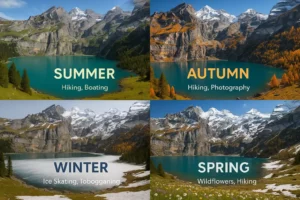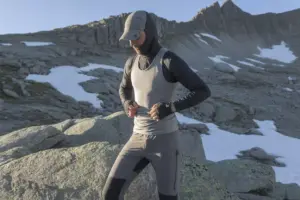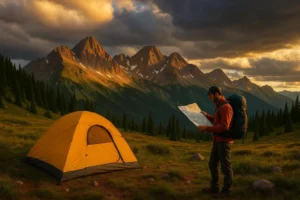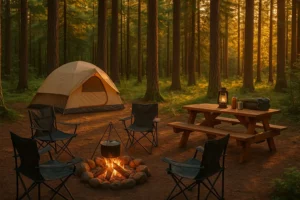Fall Asleep to the Sound of Waves: The Best Beach Camping in California
Picture this: you drift off to sleep as gentle waves crash rhythmically against the shore, wake up to a stunning Pacific sunrise, and step out of your tent directly onto golden sand. California’s coastline offers some of the most spectacular beach camping experiences in the world, where the boundary between land and sea becomes your backyard for unforgettable nights under the stars.
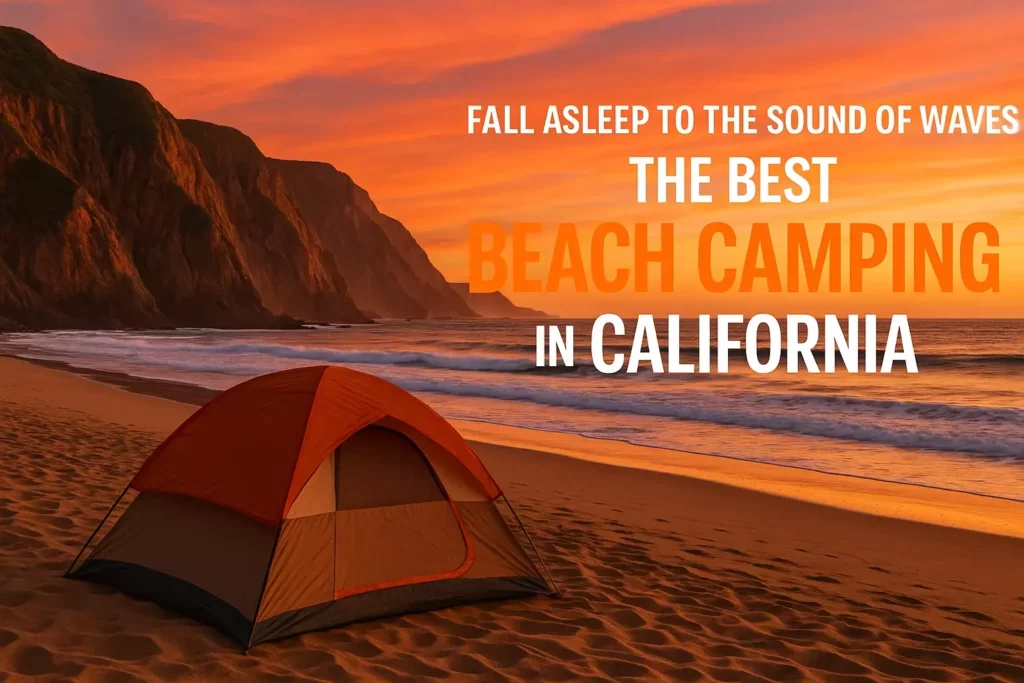
Key Takeaways
- California offers diverse beach camping options from developed state parks with amenities to primitive wilderness sites
- Reservations are essential for popular beach camping spots, especially during summer months and holidays
- Weather preparation is crucial as coastal conditions can change rapidly, requiring proper gear and clothing
- Leave No Trace principles are vital for preserving these pristine coastal environments for future generations
- Permits and regulations vary by location, so research specific requirements before your trip
Where Can You Beach Camp in California: Top Destinations
Northern California Beach Camping
Point Reyes National Seashore stands as one of California’s crown jewels for beach camping. The Coast Camp offers a unique backcountry experience just 1.4 miles from the ocean. Campers enjoy spectacular views of the Pacific while maintaining easy access to pristine beaches. The Sky Camp provides elevated views and serves as an excellent base for exploring the area’s diverse ecosystems.
Salt Point State Park delivers rugged coastal beauty with campsites perched on bluffs overlooking the ocean. The park features tide pools, hiking trails, and excellent opportunities for abalone diving (with proper permits). The combination of redwood forests and dramatic coastline creates an unforgettable camping atmosphere.
MacKerricher State Park near Mendocino offers both tent and RV camping with direct beach access. The park’s Laguna Point provides excellent whale watching opportunities, while the Ten Mile Beach stretches endlessly for morning walks and beachcombing adventures.
Central California Coastal Camping
Big Sur represents the pinnacle of California coastal camping. Pfeiffer Big Sur State Park offers redwood camping with easy beach access, while Julia Pfeiffer Burns State Park provides more intimate camping experiences. The dramatic cliffs, secluded coves, and ancient forests create an almost mystical camping environment.
Morro Bay State Park combines beach camping with unique geological features. The iconic Morro Rock serves as a stunning backdrop while campers enjoy calm bay waters perfect for kayaking and fishing. The park’s eucalyptus groves provide natural windbreaks for more comfortable camping.
Pismo Beach State Park offers extensive beach camping opportunities with both primitive and developed sites. The Oceano Dunes provide unique camping experiences directly on the sand, where you can literally park your RV or pitch your tent on the beach itself.
Southern California Beach Camping Hotspots
Channel Islands National Park, often called “California’s Galapagos,” offers primitive beach camping on Santa Cruz Island and Anacapa Island. These locations require boat transportation but reward adventurous campers with pristine beaches, crystal-clear waters, and incredible wildlife viewing opportunities.
Crystal Cove State Park in Orange County provides backcountry camping with hiking access to secluded beaches. The park’s El Moro Canyon offers a perfect blend of coastal sage scrub and beach environments.
San Elijo State Beach near Cardiff offers clifftop camping with panoramic ocean views. The campground provides easy beach access while maintaining proximity to San Diego’s attractions and amenities.
Essential Gear for Beach Camping Success
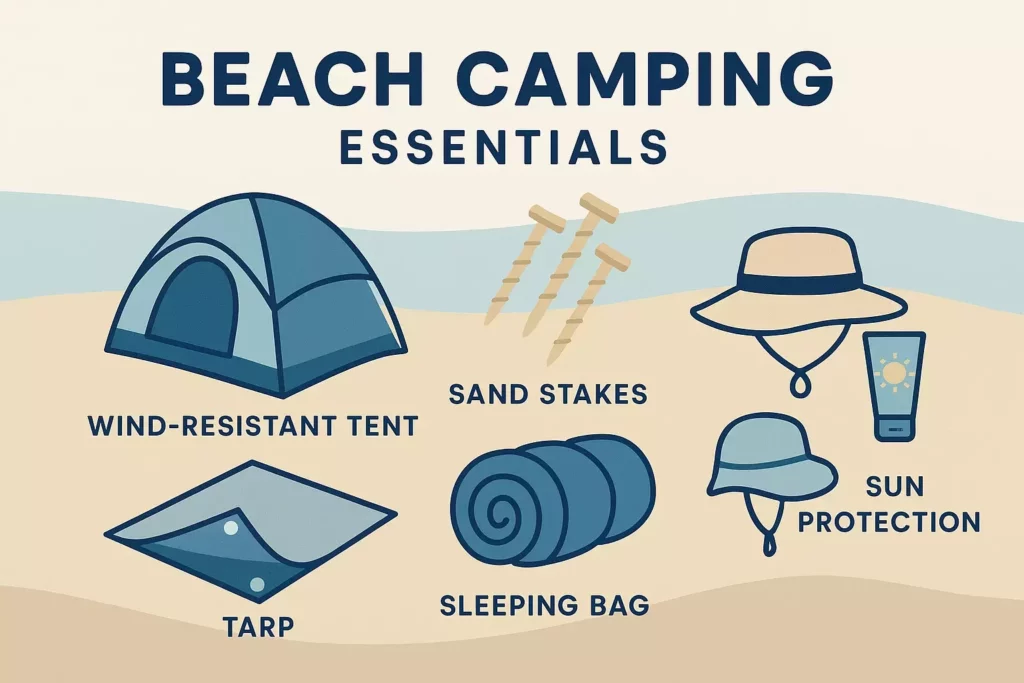
Shelter and Sleeping Systems
Beach camping requires specialized gear to handle unique coastal conditions. Wind-resistant tents are absolutely essential, as coastal winds can be unpredictable and strong. Look for tents with low profiles and multiple guy-line attachment points for maximum stability.
Choosing the right sleeping bag becomes crucial for beach camping comfort. Coastal temperatures can drop significantly at night, even during summer months. Opt for sleeping bags rated 10-15 degrees below expected nighttime temperatures to ensure warmth and comfort.
Sand stakes or sand anchors replace traditional tent stakes for beach camping. These specialized anchors dig deep into sand and provide secure tent attachment points. Alternatively, sandbags or stuff sacks filled with sand can anchor guy-lines effectively.
Protection from Elements
Tarps and windscreens create essential barriers against sand and wind. A well-positioned tarp can transform a challenging camping experience into a comfortable one by providing wind protection and additional shade during hot days.
Quality rain gear is non-negotiable for beach camping. Coastal weather changes rapidly, and fog can roll in unexpectedly, bringing moisture and temperature drops. Proper weather-appropriate clothing ensures comfort regardless of conditions.
Sun protection requires serious attention at beach campsites. The combination of direct sunlight and reflection from sand and water intensifies UV exposure. Pack high-SPF sunscreen, wide-brimmed hats, and UV-protective clothing for safe outdoor enjoyment.
Planning Your Beach Camping Adventure
Reservation Strategies
California’s beach camping popularity means advance reservations are absolutely essential. ReserveCalifornia.com handles most state park reservations, opening booking windows five months in advance. Popular sites like Big Sur and Point Reyes fill within minutes of becoming available.
Weekday camping offers better availability and rates compared to weekends. Tuesday through Thursday departures provide the best chances of securing prime beach camping spots, especially during peak season from May through September.
Shoulder season camping (March-April and October-November) delivers excellent weather with reduced crowds and easier reservations. These months often provide the most comfortable camping conditions with mild temperatures and minimal wind.
Safety Considerations and Regulations
Tide awareness is critical for beach camping safety. Research tide schedules and understand how high tides might affect your campsite location. Some beaches experience dramatic tidal changes that can impact access routes and camping areas.
Wildlife precautions vary by location but commonly include proper food storage to prevent encounters with raccoons, foxes, and occasionally bears in northern regions. Many beach camping areas require bear canisters or provide food lockers for secure storage.
Fire regulations change seasonally and by location. Many beach camping areas restrict fires to designated fire rings only, while others may implement complete fire bans during high-risk periods. Always check current regulations before your trip and have proper first aid supplies readily available.
Beach Camping Tips for Success
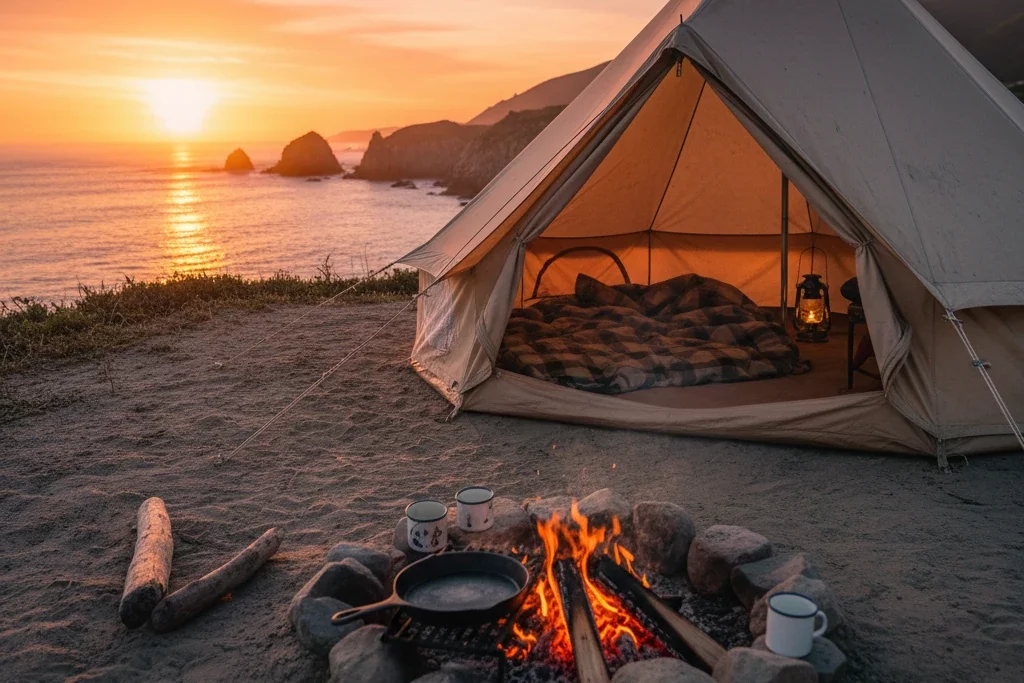
Campsite Selection and Setup
Wind direction assessment should guide campsite selection when options exist. Position tents with doors facing away from prevailing winds and use natural windbreaks like dunes or vegetation when available.
Sand management requires proactive strategies to maintain comfort. Create shoe-free zones around tents, use tarps as sand barriers, and establish designated sandy areas for beach gear storage. Proper packing techniques help organize gear and minimize sand infiltration.
Drainage considerations become important during unexpected rain or high tides. Select slightly elevated camping spots when possible and ensure tent positioning allows water runoff away from sleeping areas.
Water and Food Management
Fresh water availability varies significantly between beach camping locations. Some developed campgrounds provide potable water, while primitive sites require campers to bring all necessary water. Plan for one gallon per person per day minimum, including cooking and cleaning needs. Understanding water purification methods can provide backup options for extended stays.
Food storage and preparation requires special attention in beach environments. Salt air accelerates food spoilage, making quality coolers and ice management essential for food safety. Campfire cooking techniques can enhance the beach camping experience while reducing reliance on portable stoves in windy conditions.
Saltwater cooking offers unique opportunities for experienced campers. Fresh-caught fish, crab, and other seafood can supplement camping meals when proper licenses and regulations are followed.
Family Beach Camping Adventures
Making Beach Camping Kid-Friendly
Beach camping creates magical experiences for families, but requires additional planning for children’s safety and enjoyment. Camping with kids demands extra attention to sun protection, hydration, and age-appropriate activities.
Beach safety education should cover rip current identification, marine life awareness, and sun exposure limits. Establish clear boundaries for children’s beach exploration and maintain constant supervision near water.
Entertainment planning ensures happy campers throughout the trip. Family camping activities like sandcastle building, tide pool exploration, and beachcombing provide endless engagement opportunities. Pack sand toys, buckets for collecting, and field guides for identifying marine life and coastal plants.
Group Camping Considerations
Large group coordination requires advance planning for beach camping success. Reserve multiple adjacent sites when possible and establish group cooking areas and shared equipment strategies. Proper tent setup for groups maximizes space efficiency and comfort.
Shared responsibility systems work well for beach camping groups. Assign meal preparation duties, cleanup responsibilities, and gear management tasks to different group members throughout the trip.
Environmental Stewardship and Leave No Trace
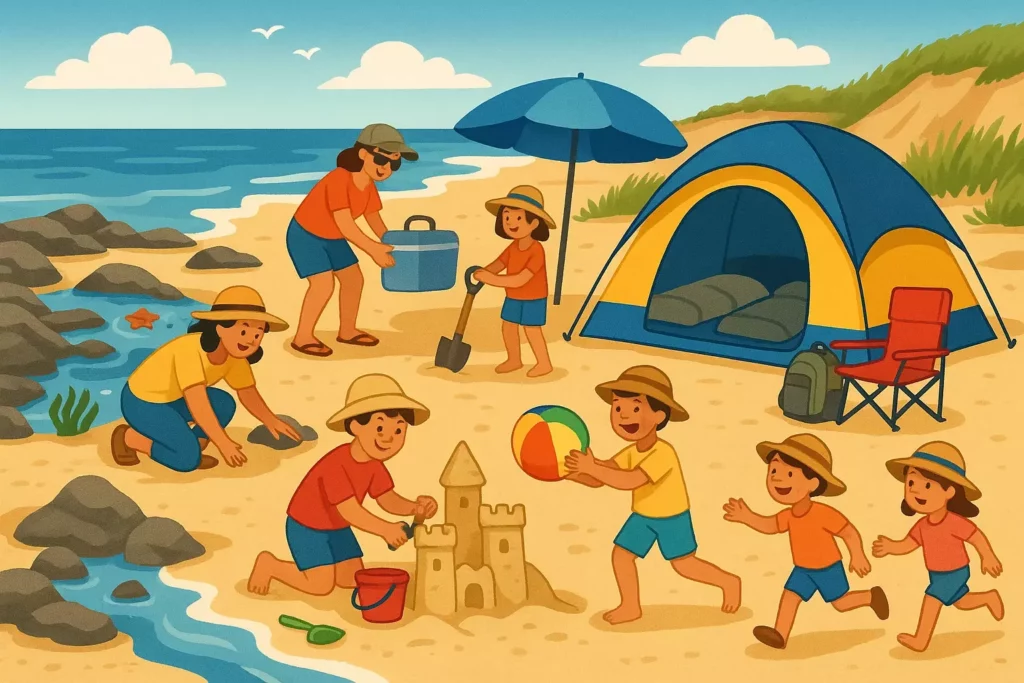
Protecting Coastal Ecosystems
California’s beach camping areas represent fragile ecosystems requiring careful protection. Dune vegetation prevents erosion and provides wildlife habitat, making it essential to stay on designated trails and avoid trampling sensitive plants.
Wildlife protection extends beyond avoiding disturbance to active conservation. Shorebird nesting areas may have seasonal closures, while marine mammal protection requires maintaining safe distances from seals, sea lions, and occasional whale strandings.
Microplastic prevention starts with campers using reusable containers, securing all lightweight items, and thoroughly cleaning campsites before departure. Even small pieces of trash can harm marine life and degrade the camping experience for future visitors.
Sustainable Camping Practices
Water conservation becomes especially important in coastal areas where freshwater resources may be limited. Use biodegradable soaps sparingly and dispose of greywater in designated areas or at least 200 feet from water sources.
Waste minimization strategies include repackaging food into reusable containers, bringing reusable water bottles, and planning meals to minimize leftovers and packaging waste.
Energy conservation through solar charging devices and efficient lighting reduces environmental impact while maintaining camping comfort and safety.
🏖️ California Beach Camping Finder
Find the perfect beach camping spot based on your preferences
No campgrounds match your current filters. Try adjusting your preferences.
Advanced Beach Camping Techniques
Weather Adaptation Strategies
Fog management requires understanding coastal weather patterns. Marine layer fog often rolls in during late afternoon and evening hours, bringing temperature drops and moisture. Pack moisture-wicking layers and waterproof gear even during apparently clear weather forecasts.
Wind camping techniques become essential skills for beach camping success. Guy-line tensioning systems and storm-proofing methods help maintain tent integrity during unexpected weather changes. Understanding how to read wind patterns and adjust camp setup accordingly prevents equipment damage and ensures comfortable nights.
Temperature regulation in coastal environments requires layered clothing systems. Beach camping temperatures can fluctuate 20-30 degrees between day and night, making versatile clothing choices and quality sleeping systems essential for comfort.
Advanced Site Selection
Microclimate identification can dramatically improve camping comfort. Protected coves and natural windbreaks create more comfortable camping conditions than exposed beach areas. Understanding topographical features and their effects on wind and weather helps experienced campers select optimal sites.
Tide pool timing coordination enhances the beach camping experience. Low tide exploration reveals incredible marine life and geological features, while high tide safety requires understanding how water levels affect beach access and campsite security.
Sunrise and sunset positioning considerations can transform ordinary camping into magical experiences. Eastern exposure provides spectacular sunrise views, while western positioning offers stunning sunset photography opportunities.
Seasonal Beach Camping Considerations
Summer Peak Season (June-August)
Summer beach camping requires heat management strategies and crowd navigation skills. Early morning activities and evening beach time avoid peak heat and sun exposure while providing optimal lighting for photography and exploration.
Reservation competition reaches its peak during summer months. Flexible date planning and alternative site options increase chances of securing desired camping spots. Consider mid-week arrivals and shorter stays to improve availability.
Wildlife activity changes during summer months, with increased marine life and bird migration patterns providing excellent viewing opportunities. Respectful wildlife observation maintains safe distances while maximizing educational experiences.
Shoulder Season Advantages (March-May, September-November)
Optimal weather conditions often occur during shoulder seasons, with mild temperatures, reduced wind, and clearer skies creating ideal camping conditions. Whale migration seasons provide spectacular viewing opportunities during these months.
Reduced crowding allows for more intimate beach experiences and easier access to popular tide pools and hiking trails. Photography opportunities improve with fewer people and more dramatic lighting conditions.
Cost savings during shoulder seasons extend beyond camping fees to include reduced fuel costs and lower food prices in tourist areas. Local business availability remains high while prices stay reasonable.
Winter Beach Camping (December-February)
Storm watching provides dramatic entertainment during winter beach camping. Safe viewing positions and weather monitoring ensure exciting experiences without compromising safety. Powerful wave action and dramatic skies create unforgettable memories.
Solitude opportunities reach their peak during winter months. Private beach experiences and quiet contemplation appeal to campers seeking peaceful getaways from busy urban environments.
Preparation requirements increase during winter camping. Cold weather gear, extended food supplies, and emergency preparedness become more critical for safe and comfortable experiences.
Regional Specialties and Unique Experiences
Northern California’s Rugged Beauty
Redwood proximity distinguishes northern California beach camping from other regions. Ancient forest exploration combined with dramatic coastline access creates unique camping experiences unavailable elsewhere in the state.
Cooler temperatures and frequent fog require different preparation strategies but reward campers with mystical atmospheres and exceptional photography opportunities. Tide pool diversity reaches its peak in northern regions.
Cultural experiences include lighthouse visits, historic coastal towns, and artisan communities that add educational and cultural elements to beach camping adventures.
Central Coast’s Dramatic Landscapes
Big Sur’s iconic scenery provides world-class camping backdrops with towering cliffs, pristine beaches, and ancient redwood groves. Photography opportunities abound with dramatic rock formations and secluded coves.
Marine sanctuary proximity offers exceptional wildlife viewing with sea otters, harbor seals, and diverse bird species. Kelp forest snorkeling provides underwater exploration opportunities for advanced campers.
Artisan communities and farm-to-table dining enhance camping experiences with local wine tasting, fresh seafood, and cultural events throughout the year.
Southern California’s Accessible Paradise
Year-round camping weather makes southern California beaches ideal for winter escapes and extended camping seasons. Consistent temperatures and predictable weather patterns simplify planning and gear selection.
Urban proximity provides supply access, emergency services, and entertainment options while maintaining natural beach experiences. Family-friendly amenities and developed facilities accommodate various camping skill levels.
Water sports opportunities expand with warmer water temperatures, consistent surf, and protected bay areas perfect for kayaking, paddleboarding, and swimming.
Conclusion
California’s diverse coastline offers unparalleled beach camping opportunities, from the rugged wilderness of Point Reyes to the family-friendly beaches of Southern California. Whether you’re seeking primitive backcountry adventures or developed campgrounds with full amenities, knowing where you can beach camp in California opens doors to unforgettable coastal experiences.
Success in beach camping requires proper preparation, quality gear, and respect for these precious coastal environments. The rhythmic sound of waves, spectacular sunrises, and direct beach access create memories that last a lifetime. Proper gear selection, advance planning, and environmental stewardship ensure these magical places remain available for future generations.
Ready to plan your beach camping adventure? Start by selecting your preferred region, making reservations well in advance, and preparing for the unique challenges and rewards of coastal camping. The California coast awaits with its endless beaches, dramatic landscapes, and the timeless appeal of falling asleep to the sound of waves.


